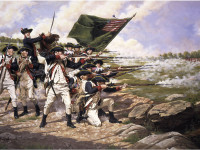After the declaration of independence of the United States of America, the country declared its political and military neutrality for the conflicts on the European mainland. France, in particular, was disappointed with this decision because the country was at war with England and demanded a return from the Americans for their help in the Revolutionary War.
These tensions between France and the US even culminated in an unofficial naval war between 1798 and 1800 in which warships and merchant ships were attacked.
Only with the trade blockade of American goods to France and the compulsory recruitment of US sailors for the Royal Navy, England and the US again headed for war.
The beginning of the war:
The United States declared its war on England on June 18, 1812. Acting President James Madison followed the demands of his supporters, the so-called "hawks," who advocated an expansion to extend the American territory significantly westward and northward into Canadian territory.
At the time, however, the US had only a small standing army, since after Independence more emphasis was placed on the individual militias of each state than on a common army. In addition, Madison insisted that the British forces in Canada were tied by the ongoing war with France elsewhere and their own soldiers are sufficient for a occupation.
The campaign against Canada took place in August 1812, but could be repelled by the British soldiers along with the Canadian militia and the native Indians. These defeats now shifted the strategy more to naval warfare. Although the young US Navy was hopelessly inferior to the Royal Navy with about 700 ships with 17 ships, the heavily armed American warships still achieved successes with their raids, as they avoided open combat and largely helped the British ships the blockade of the French ports. The most important for the war victory with ships, however, was achieved on Lake Erie. A small, locally built squadron under the leadership of Oliver Perry, was able to beat the British and on 10 September 1813 gain control of the lake. Thus, Detroit was recaptured and control of Ohio secured. The evacuation of the Detroit occupation forces also killed the British-led leader of the Shawnee Indians Tecumsehs.
In the summer of 1814 was the second invasion of Canada under the leadership of General Winfield Scott. In Chippewa he was able to beat the British for the first time, in July 1814, the second clash took place at Lundy's Lane, where the general was severely wounded and the campaign ended.
In the south of the US, the troops had to resist the revolting Indians. Under the leadership of Colonel Andrew Jackson, the US soldiers fought against supporters of the Creek tribe. With his militia, he defeated in March in March at Horseshoe Bend the tribe and let the Indians massacre brutal mass for the most part.
The turn of the war:
In April 1814 Napoleon was deposed in France and the now liberated British troops and warships could be used in the conflict with the United States. So it was that the Royal Navy quickly regained absolute control of the East Coast of the United States and could also muster the frigates USS Chesapeake and Essex. In addition, the ports of the United States were now blocked, which was crucial to the economy.
In August 1814, the British, with the incoming troops from Europe decide the US capital Washington D.C. attack. Under the leadership of General Robert Ross, the British succeeded in quickly expelling the Washington-based militias and taking over the city. Subsequently, parts of the public buildings were set on fire.
In September, the British concentrated on the city of Baltimore, could not take the Fort McHenry built there despite shelling from the sea and broke off the siege. An invasion of Canada to conquer the state of New York failed due to the bitter resistance of the Americans. Only Maine could take the British.
By the end of 1814, both forces were so exhausted that everyone wanted to settle only in a favorable position for the upcoming peace negotiations in Geneva. This treaty was signed on December 24, 1814 and ended the conflict.
Aftereffects
There was no winner in this conflict. The British had to relinquish all conquered cities to the US, which only gained the city of Mobile, which they got from Spain, even though the country had not been involved in the conflict.
Further, after the war, the subjugation of the Indians was promoted. In the Seminole War from 1817 to 1818 General Andrew Jackson led some campaigns against runaway slaves and Indians in Florida, which was ceded in 1819 from Spain to the United States. When Jackson was President of the United States in 1830, the Indian Removal Act was enacted under him, which legalized the expulsion of Indians from their tribal areas and penned them into reserves.
This post is also available in:
 Deutsch (German)
Deutsch (German)  Français (French)
Français (French)  Italiano (Italian)
Italiano (Italian)  简体中文 (Chinese (Simplified))
简体中文 (Chinese (Simplified))  Русский (Russian)
Русский (Russian)  Español (Spanish)
Español (Spanish)  العربية (Arabic)
العربية (Arabic)










